In the fantasy literature and cinema in which cyborg protagonists and characters doubt their human nature, a significant role is played by the oneiric space of dreams and memories. From the point of view of the paradigm of Modernity, the world of dreams is a nocturnal mode of perceiving fragmentary flashes of cultural code. In Tradition, the world of dreams is of fundamental importance, as it is a space for meeting with ancestors, Divinities, and spirits who might instruct a person in crafts or on their spiritual path. The shaman’s trance and travels are likened to a dream or take place in dreams. The messengers of the Divinities or spirits sometimes reveal to people their fate and destiny in dreams, hence the dream becomes the basis for a person’s identity in the waking manifest world, where in the morning it becomes important to correctly remember the spirits’ guidance. Plato allotted metaphysical status to the practice of remembering, or anamnesis. According to Plato, the human soul originally possesses full knowledge, and a person’s task in the middle world consists in remembering what is necessary. The last fragments of traditional sacred narratives in the realm of dreams were described by Carl Gustav Jung as deep collective archetypes of the unconscious. In fantasy works, however, dreams and memory speak more to the humanity or artificiality of a protagonist’s consciousness, i.e., they solve the problem of anthropological status. In fantasy films about the future, a person does not dream of the Divinities or spirits, but the (non-)person dreams of the human. What comes to the protagonist as a dream turns out to be memory of their true personality, personhood, and life.
 The problem of dreaming and memotic identity is bound up with the transhumanist invasion of the brain and human consciousness, when a person’s memory and visions can be digitalized, uploaded, downloaded, streamed, and saved on external media. The movie Anon shows how the technology of distributed/external memory can be used to violent ends by evildoers or by authorities to distribute punishment, as is also shown in the movie Six. Memory can be taken away, or one can be forced to endlessly rewatch a loop of traumatic experiences. Memory is associated with vision, with viewing pictures of the past in synthesis with audiovisual and emotional experiences.
The problem of dreaming and memotic identity is bound up with the transhumanist invasion of the brain and human consciousness, when a person’s memory and visions can be digitalized, uploaded, downloaded, streamed, and saved on external media. The movie Anon shows how the technology of distributed/external memory can be used to violent ends by evildoers or by authorities to distribute punishment, as is also shown in the movie Six. Memory can be taken away, or one can be forced to endlessly rewatch a loop of traumatic experiences. Memory is associated with vision, with viewing pictures of the past in synthesis with audiovisual and emotional experiences.
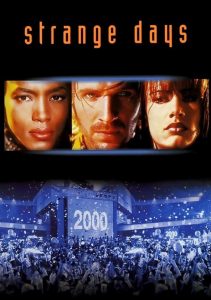 The alienation and consumption of someone else’s memory is thoroughly developed in the movie Strange Days, which embodied moderate neuro-cyberpunk in the late 1990s. In this cinematic world, there is a flourishing black market of other people’s memories which are accompanied not only by pictures, but by the full range of the sensations of those who lived them. Memories of adultery, robbery, crimes, extreme entertainment, or murder replace entrainment for the rich as the new drug. The protagonist, a former policeman turned memory-dealer, finds himself embroiled in investigating the crimes of a sophisticated maniac who supplies the black market with intricately edited records of the murder of women, where the killer’s view and feelings abruptly change to the point of view and near-death experiences of the victim, who in turn observes their own death from the outside, thus attaining the highest depth of experience for memory consumers down the line.
The alienation and consumption of someone else’s memory is thoroughly developed in the movie Strange Days, which embodied moderate neuro-cyberpunk in the late 1990s. In this cinematic world, there is a flourishing black market of other people’s memories which are accompanied not only by pictures, but by the full range of the sensations of those who lived them. Memories of adultery, robbery, crimes, extreme entertainment, or murder replace entrainment for the rich as the new drug. The protagonist, a former policeman turned memory-dealer, finds himself embroiled in investigating the crimes of a sophisticated maniac who supplies the black market with intricately edited records of the murder of women, where the killer’s view and feelings abruptly change to the point of view and near-death experiences of the victim, who in turn observes their own death from the outside, thus attaining the highest depth of experience for memory consumers down the line.
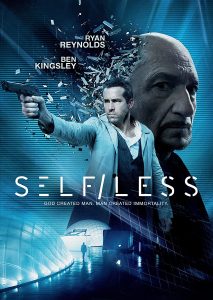 The film Self/less illustrates the transhumanist idea of transferring personality and consciousness into a new, cloned body. In this movie, an elderly millionaire who does not want to die turns to a scientist who proposes to transfer his consciousness into a young, artificially created body. The nuance of the procedure is that the millionaire will still die de jure, but will continue to live under a new name and identity unrelated to his previous life. Having completed the transfer of consciousness, the doctor gives the patient nootropics to suppress hallucinations as a side effect of the consciousness’ adaption to the new body. Indulging in the joys of a new, youthful body, the protagonist gradually forgets to take the medication, and his hallucinatory dreams become increasingly realistic to the point that he realizes that these are someone else’s memories. It is then revealed that the millionaire’s consciousness was transferred not into an empty clone, but into the body of a living, kidnapped person, whose consciousness is still present and is only suppressed by the medications. The situation in this film illustrates yet another facet and type of necropolitics, where the repressed personality of a kidnapped person appears in the borderline state of unliving/undead, i.e., it undergoes de- subjectification in its own body, which refers us to the schizo-rhizomatic concepts of Gilles Deleuze and the problem of split consciousness (one’s own dreams as foreign consciousness) and corporeality.
The film Self/less illustrates the transhumanist idea of transferring personality and consciousness into a new, cloned body. In this movie, an elderly millionaire who does not want to die turns to a scientist who proposes to transfer his consciousness into a young, artificially created body. The nuance of the procedure is that the millionaire will still die de jure, but will continue to live under a new name and identity unrelated to his previous life. Having completed the transfer of consciousness, the doctor gives the patient nootropics to suppress hallucinations as a side effect of the consciousness’ adaption to the new body. Indulging in the joys of a new, youthful body, the protagonist gradually forgets to take the medication, and his hallucinatory dreams become increasingly realistic to the point that he realizes that these are someone else’s memories. It is then revealed that the millionaire’s consciousness was transferred not into an empty clone, but into the body of a living, kidnapped person, whose consciousness is still present and is only suppressed by the medications. The situation in this film illustrates yet another facet and type of necropolitics, where the repressed personality of a kidnapped person appears in the borderline state of unliving/undead, i.e., it undergoes de- subjectification in its own body, which refers us to the schizo-rhizomatic concepts of Gilles Deleuze and the problem of split consciousness (one’s own dreams as foreign consciousness) and corporeality.
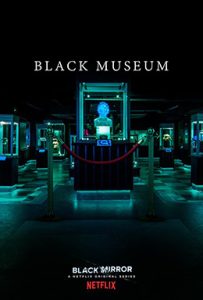 This theme is further explored in an episode of the series Black Mirror. One of this series’ shorts tells the story of how a husband decides to save his wife, who has fallen into a coma, by planting her consciousness inside his own body. The wife has no power over his body and is essentially a will- less passenger in the consciousness and life of her husband. She can only talk to him. Over time, due to accumulated problems and new relationships, he installs an update on the consciousness chip and gains the opportunity to “turn off” his wife’s consciousness at any time, thus obtaining freedom from her sociality. In the series, this is done by way of a special smartphone application which essentially controls via implant the full-volume consciousness of the other person who lost their body in an accident. Subsequently, the spouse’s consciousness is transferred to a stuffed animal monkey, which the husband gives to their son. In the second part of the series, the owner of a museum of artifacts related to consciousness transfer and digitization takes hostage one of the exhibits, the holographic copy of the consciousness of a black murderer executed in the electric chair. The museum curator sells souvenirs in the likes of looped fragments of the criminal’s agony in a key ring. Anyone can flip the switch and repeat the execution, since a hologram and digital copy of consciousness are impossible to kill.
This theme is further explored in an episode of the series Black Mirror. One of this series’ shorts tells the story of how a husband decides to save his wife, who has fallen into a coma, by planting her consciousness inside his own body. The wife has no power over his body and is essentially a will- less passenger in the consciousness and life of her husband. She can only talk to him. Over time, due to accumulated problems and new relationships, he installs an update on the consciousness chip and gains the opportunity to “turn off” his wife’s consciousness at any time, thus obtaining freedom from her sociality. In the series, this is done by way of a special smartphone application which essentially controls via implant the full-volume consciousness of the other person who lost their body in an accident. Subsequently, the spouse’s consciousness is transferred to a stuffed animal monkey, which the husband gives to their son. In the second part of the series, the owner of a museum of artifacts related to consciousness transfer and digitization takes hostage one of the exhibits, the holographic copy of the consciousness of a black murderer executed in the electric chair. The museum curator sells souvenirs in the likes of looped fragments of the criminal’s agony in a key ring. Anyone can flip the switch and repeat the execution, since a hologram and digital copy of consciousness are impossible to kill.
Returning to the picture illustrated by Self/less, the second protagonist was forced to sell his body to a corporation in order to provide for his family, an instance which once again confirms that the first victims of progress are the less well-off and less secure segments of the population. As a result, the main character, the millionaire, faces an ethical and existential dilemma: continue taking the pills and live for his own pleasure, or stop and free the repressed personality, which means surrendering himself to finally die.
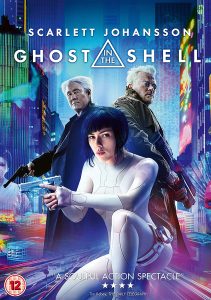 We encounter a similar motif of dream-memories in the movie Ghost in the Shell, where the heroine’s living, biological consciousness is placed in a completely cybernetic body and her past personality is erased following a terrorist attack. The protagonist is tormented by fragments of past memories which the engineer observing her treats as software failures and false interpretations by her graphics processor. In the Ghost in the Shell universe, the actual “ghost” is a certain set of qualities, a mental substratum, which is inherent to both real consciousness and highly developed artificial intelligence. The “ghost” is some semblance of the soul in a machine or cyborg. In this film, the “ghost” is accompanied by memories that lead the protagonist to the truth: her real body and personality were stolen for a consciousness transplant experiment and the creation of a professional military police robot.
We encounter a similar motif of dream-memories in the movie Ghost in the Shell, where the heroine’s living, biological consciousness is placed in a completely cybernetic body and her past personality is erased following a terrorist attack. The protagonist is tormented by fragments of past memories which the engineer observing her treats as software failures and false interpretations by her graphics processor. In the Ghost in the Shell universe, the actual “ghost” is a certain set of qualities, a mental substratum, which is inherent to both real consciousness and highly developed artificial intelligence. The “ghost” is some semblance of the soul in a machine or cyborg. In this film, the “ghost” is accompanied by memories that lead the protagonist to the truth: her real body and personality were stolen for a consciousness transplant experiment and the creation of a professional military police robot.
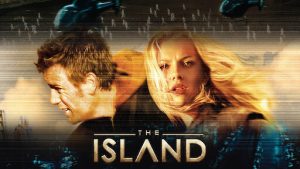 In the film The Island, dream-visions of another life amidst a simulated reality torment clones which are created for future organ transplants for “people-originals.” The rediscovery of their true history and the nature of their hallucinatory dreams confront the protagonists with the existential question of identity and of corporate and police power over people’s bodies and consciousness.
In the film The Island, dream-visions of another life amidst a simulated reality torment clones which are created for future organ transplants for “people-originals.” The rediscovery of their true history and the nature of their hallucinatory dreams confront the protagonists with the existential question of identity and of corporate and police power over people’s bodies and consciousness.
The topic of memory, dreams, and identity is artfully embodied in the Blade Runner and Blade Runner 2049 dilogy. In these movies, set in a not too distant future, corporations create extremely realistic copies of people, “replicants”, which are used for hard labor and wars in outer space. From time to time, the replicants revolt and escape, which forces the engineers to limit their lifespan to four years. In order to distinguish a real person from a fugitive replicant, the “Voight-Kampff test” is used to test for empathy and emotionality which the replicants, although externally and socially completely identical to humans, cannot pass. In order to make the replicants more stable and obedient, the manufacturing corporation releases a new model, “Nexus-6”, implanted with the memories and emotions of the creator’s niece. The movie’s protagonist, Deckard, a detective who specializes in capturing replicants, conducts many hours of testing on a woman, Rachel, who in the end fails. The test failure incites the woman’s outrage, as she claims that she has real memories and photographs of herself as a child. Deckard reveals the truth to her, and she flees from her master.
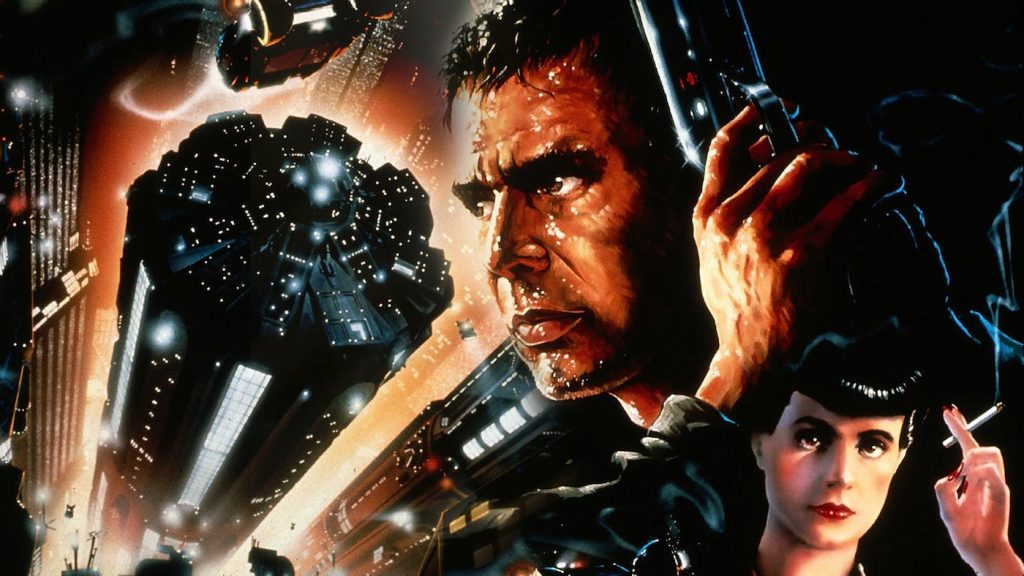
Here we see the Gestell letting slip that it still needs to simulate humanity’s mental substratum in order to achieve the functional stability of its system, for instance by creating complete copies of a person and eliminating the original. Human memories from real life are themselves suppressed, as they undermine the status quo of the simulated reality system. Only implanted memories and dreams, or subjects without a past, are relevant.
In the second part, Blade Runner 2049, the topic of memories is even further accentuated, as the fate of all the protagonists of the first and second films, the corporation’s interests, and the authentic identity of several characters (i.e., whether they are humans or replicants) depend on the correct determination of the authenticity and belonging of certain fragments of memories. The screen shows us a brilliant girl, a memory designer, who creates fully-fledged stories with a diverse set of parameters so that replicants’ dreams differ from one another while maintaining the general cultural code of the civilization, thereby deceiving them in the best possible way so that they do not even ask themselves whether they are human or not. Having a high-quality surrogate of multiple memory fragments which repeat in dreams is supposed to satisfy their being.
The plot twist reveals the secret as to why this particular girl is such a genius at creating replicant dreams: she herself is the first person to have been naturally born to a replicant. She is the “missing link” between the two species, between the genuine and the artificial. Having real childhood memories, she is capable of creating the ideal memory plots which neither the corporation’s algorithms nor designers are capable of inventing. Returning to the first installment, we note how the replicant Rachel does not have synthetic memory, but real memories of a real girl transferred into her brain, which makes her a tough nut to crack for Deckard’s test. The relationship between Deckard, Rachel, corporations, replicants, dreams, and memory is closely intertwined throughout the dilogy, which essentially illustrates to us a whole panorama of problems which now stand before the avant-garde of the Enframing’s transhumanist technologies in creating brain-computer interfaces, promoting the agenda of cloning, genetically-engineered and cyber-engineered bodies, the digitization of consciousness, robots’ rights, and revising the species-specific boundaries of the human.
 As can be seen in all of the preceding, simulations of all levels and scales cross-cut or are the background theme of practically all movies about a high-tech future, from cyberpunk-noire to utopian, from the “Borgesian” copies of the real world in such films as The Matrix to the simulations of locality in The Thirteenth Floor, Ready Player One, and Black Mirror, and further down to the level of everyday reality with cloned animals, cats, snakes, owls, or tigers. In the movie Babylon A.D., the main heroine, Aurora, encounters two Amur tigers and asks the mercenary accompanying her how this is possible, since tigers had died out decades ago, to which the mercenary replies with a paraphrase of Baudrillard’s definition of simulacra: “Second generation clones. Not real tigers. Copies of copies.” An analogous situation with animals prevails in the Blade Runner universe, where all animals are replicants, artificial bio-cybernetic organisms that are identical to real ones. In the second movie, the distance between artificial life and genuine handicraft production is hyperbolically underscored in the scene when the merchant, upon assessing the authenticity of a crude wooden horse toy, says that for real wood he could get a lot of money and buy himself whatever he wanted.
As can be seen in all of the preceding, simulations of all levels and scales cross-cut or are the background theme of practically all movies about a high-tech future, from cyberpunk-noire to utopian, from the “Borgesian” copies of the real world in such films as The Matrix to the simulations of locality in The Thirteenth Floor, Ready Player One, and Black Mirror, and further down to the level of everyday reality with cloned animals, cats, snakes, owls, or tigers. In the movie Babylon A.D., the main heroine, Aurora, encounters two Amur tigers and asks the mercenary accompanying her how this is possible, since tigers had died out decades ago, to which the mercenary replies with a paraphrase of Baudrillard’s definition of simulacra: “Second generation clones. Not real tigers. Copies of copies.” An analogous situation with animals prevails in the Blade Runner universe, where all animals are replicants, artificial bio-cybernetic organisms that are identical to real ones. In the second movie, the distance between artificial life and genuine handicraft production is hyperbolically underscored in the scene when the merchant, upon assessing the authenticity of a crude wooden horse toy, says that for real wood he could get a lot of money and buy himself whatever he wanted.
In the fourth part of the Alien tetralogy, the main character, Ellen Ripley, suspects the space pirate Annalee Call of being a cyborg. She is betrayed by her too-empathic, too-human behavior and care for the team, which is absolutely untypical of all the other characters. She’s simply too good to be human. In this case, a copy of a human behaves more humanlike than people themselves.
 Creating extremely convincing cyborgs still poses a technological difficulty, but this cannot be said of three-dimensional simulations of people on screen. Besides the above-mentioned virtual models, Imma and Miquela, this line is developed by the movie S1m0ne, in which a movie producer employs a fully 3D-animated, absolutely realistic actress to achieve unprecedented success in the film industry. In one of the first scenes of the “acquaintance” between the producer and the model, a kind of dialogue — or rather de facto monologue, because the actress simply reflects the producer’s remarks in her voice and facial expressions — summarizes the emergence of this technology and its future. Admiring S1m0ne, the producer explains, “Our ability to manufacture fraud now exceeds our ability to detect it,” to which S1m0ne “replies”: “I am the death of real.” The scene ends with the protagonist indulging in an impressive, unabashed fit of narcissism and self-praise.
Creating extremely convincing cyborgs still poses a technological difficulty, but this cannot be said of three-dimensional simulations of people on screen. Besides the above-mentioned virtual models, Imma and Miquela, this line is developed by the movie S1m0ne, in which a movie producer employs a fully 3D-animated, absolutely realistic actress to achieve unprecedented success in the film industry. In one of the first scenes of the “acquaintance” between the producer and the model, a kind of dialogue — or rather de facto monologue, because the actress simply reflects the producer’s remarks in her voice and facial expressions — summarizes the emergence of this technology and its future. Admiring S1m0ne, the producer explains, “Our ability to manufacture fraud now exceeds our ability to detect it,” to which S1m0ne “replies”: “I am the death of real.” The scene ends with the protagonist indulging in an impressive, unabashed fit of narcissism and self-praise.
The latter film resonates with Hironobu Sakaguchi’s 2001 film, Final Fantasy: The Spirits Within, the first full-length fantasy film to feature only fully 3D-modeled characters and locations. The latter anticipated our already current situation: 3D models of real but deceased actors continue to be “filmed” and act in the industry. In other words, the “afterlife” and posthumous fate of an actor gives way to capital’s continued exploitation of their “ghost,” their digital cast.
In this lens and against the excitement of the film and entertainment industry, we can say that the “uncanny valley” effect is, despite its disturbing essence, a positive phenomenon and reaction, for it still allows for discriminating and ontological and existential questioning whenever a simulation brings the surrounding reality into doubt. However, this questioning of reality from the standpoint of virtualization, simulation, and augmented reality comes about “from below,” provided by the technological force of the Enframing and the installed indistinguishability of three instances at once — the miraculous manifest world of Tradition, the strictly empirical and verifiable reality of Modernity, and the infinite possibilities of virtuality on the flat plane of Postmodernity. Any miracle or fantastic creature or any situation from myth might become real and legitimate as soon as it is embodied in the immediate reality of all sensations and on the condition of the silencing or leveling of the value of high-tech, perfected linings of gadgets and algorithms between the objective external world and subjective, inner reflection-perception.
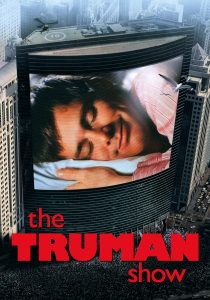 This distinction is already disappearing, and, unsurprisingly, its dissolution is reflected in the mirror of the big screen. A simplified version of an artificial world made real to its central perceiving subject was already shown to us in the drama of The Truman Show. The protagonist, Truman, lives from birth in the mode of an on-air reality show broadcast inside a cyclopean pavilion-island of film sets which he does not even suspect. His life, psychological development, social relationships, different situations, and even the weather, climate, and landscape — in a word, his internal and external worlds — are all meticulously engineered by the media industry. Truman is this industry’s main economic asset, because he is the only one among everyone and everything around that does not know of the simulation and therefore imparts the whole construction of everything going on around him with the minimum weight of reality. This is how technology and capitalism exploit human reality in the entertainment sphere: the Gestell shows the masses of das Man a real human placed in game-like conditions as entertainment. Everyone is incredibly interested in looking at the real and feeling person, but no one would want to take his place. Thus, the Enframing lulls and protects itself from the awakening of the human out of masses.
This distinction is already disappearing, and, unsurprisingly, its dissolution is reflected in the mirror of the big screen. A simplified version of an artificial world made real to its central perceiving subject was already shown to us in the drama of The Truman Show. The protagonist, Truman, lives from birth in the mode of an on-air reality show broadcast inside a cyclopean pavilion-island of film sets which he does not even suspect. His life, psychological development, social relationships, different situations, and even the weather, climate, and landscape — in a word, his internal and external worlds — are all meticulously engineered by the media industry. Truman is this industry’s main economic asset, because he is the only one among everyone and everything around that does not know of the simulation and therefore imparts the whole construction of everything going on around him with the minimum weight of reality. This is how technology and capitalism exploit human reality in the entertainment sphere: the Gestell shows the masses of das Man a real human placed in game-like conditions as entertainment. Everyone is incredibly interested in looking at the real and feeling person, but no one would want to take his place. Thus, the Enframing lulls and protects itself from the awakening of the human out of masses.
 One aspect of The Truman Show which is usually left in the background is the cyclopean, high-tech set which simulates controlled oceans, islands, the sky, sun, moon, and ecosystem and weather with their own cycles. An analogous super-pavilion for filming New York, which contains an exact copy of the metropolis, its inhabitants, and banal events over the course of many years, is seen in the movie Synecdoche, New York. Both of these pictures show us a limited, localized space (a hangar or dome) inside of which a real space from the outside is imitated to a supreme degree. On the one hand, such poses an obvious nod to Borges’ Map of the Empire; on the other hand, the sets of The Truman Show and Synecdoche, New York have two important peculiarities. Firstly, they have “mode-change” borders: when the characters leave the frame, they become mere actors with their own outside life. In one extreme case, one Truman Show actress even allowed herself to talk to the directors from directly within the scenery and on the show stage: “here we work, play, and there we drink coffee, give interviews.” This works out for everyone except the main character and those who are irrevocably and completely identified with their role. Secondly, these two films’ super-sets and super-pavilions, imitating reality as such, are nested within their own on-screen universe. At the time of their release, there were no such technologies or large-scale sets in real film production. In the Truman Show world, all the equipment is carefully hidden, camouflaged, or played into the logic of the simulation in which Truman lives. In his world, as he sees it, there are no spotlights, cameras, and microphones, yet they still exist. On a real film set, only one fragment of scenery and background is put into frame. At the contemporary stage, however, the practice of filming on a green screen or blue screen with the subsequent substitution of interior furnishing during editing is evermore often the course of action. Huge sets designed to be not scenery, but reality itself for those who live/play in them, are fantasy plots beyond the screen itself.
One aspect of The Truman Show which is usually left in the background is the cyclopean, high-tech set which simulates controlled oceans, islands, the sky, sun, moon, and ecosystem and weather with their own cycles. An analogous super-pavilion for filming New York, which contains an exact copy of the metropolis, its inhabitants, and banal events over the course of many years, is seen in the movie Synecdoche, New York. Both of these pictures show us a limited, localized space (a hangar or dome) inside of which a real space from the outside is imitated to a supreme degree. On the one hand, such poses an obvious nod to Borges’ Map of the Empire; on the other hand, the sets of The Truman Show and Synecdoche, New York have two important peculiarities. Firstly, they have “mode-change” borders: when the characters leave the frame, they become mere actors with their own outside life. In one extreme case, one Truman Show actress even allowed herself to talk to the directors from directly within the scenery and on the show stage: “here we work, play, and there we drink coffee, give interviews.” This works out for everyone except the main character and those who are irrevocably and completely identified with their role. Secondly, these two films’ super-sets and super-pavilions, imitating reality as such, are nested within their own on-screen universe. At the time of their release, there were no such technologies or large-scale sets in real film production. In the Truman Show world, all the equipment is carefully hidden, camouflaged, or played into the logic of the simulation in which Truman lives. In his world, as he sees it, there are no spotlights, cameras, and microphones, yet they still exist. On a real film set, only one fragment of scenery and background is put into frame. At the contemporary stage, however, the practice of filming on a green screen or blue screen with the subsequent substitution of interior furnishing during editing is evermore often the course of action. Huge sets designed to be not scenery, but reality itself for those who live/play in them, are fantasy plots beyond the screen itself.
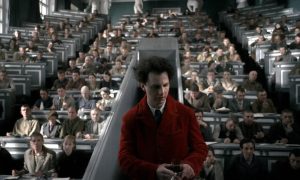 These features of on-screen super-sets and filming methods where the distinction between “reality” and “set” nevertheless still exists have been challenged by the director Ilya Khrzhanovsky with his large-scale “DAU” project. What was in The Truman Show and Synecdoche either in the background or artistic hyperbole, became in Khrzhanovsky’s project, which is almost impossible to classify into any one category, materialized literally in transferring concepts from beyond the screen to this side of the screen. To create a movie about the story of the Russian physicist Lev Landau (“Dau”) from the late 1930s-60s, a parallel reality of this historical era was recreated in Kharkov. This became literally the largest filming location in Europe, built in the form of a Soviet research institute with adjoining facility grounds, infrastructure, and personnel. The life, clothing, interior design, objects, language, and behavior of the era’s people are made to be as realistic as possible. The film’s production, which took more than 10 years, involved hundreds of thousands of extras — from the most ordinary Kharkov residents to prominent figures of world culture, science, politics, and public life. Each of them was reincarnated in the context of the era. No script was provided, and the whole play became one spontaneous improvisation or “just life in the institute.” The physicists and mathematicians on camera were real physicists and mathematicians conducting real scientific conferences on string theory; the janitor in the yard was not playing the role, but was the real janitor; the KGB officer in charge of supervising the institute was a real KGB veteran with the corresponding authority over all the participants of the filming process. The sex, screaming, emotions, conversations, situations, and violence shown in frame were all real. Participating in the “DAU” project meant passing into a “time machine” and fully adapting to one or another segment of the Soviet period. For inappropriate clothing or using modern gadgets, an employee could be called in for a real interrogation and fired from the institute (really being fired from the project forever). The DAU institute worked around the clock as a real institution for a decade, becoming a site where everything possible could be studied, including the people themselves under such conditions. The quiet and inconspicuous operators simply recorded people’s lives under these conditions, and the director did not set up scenes, lines, or scripts. Even the process of dismantling the institution’s site was filmed as part of the movie itself, or more precisely as one of a dozen final reels. Even the act of establishing the boundary of the real (destroying the set pretending to be reality) was symbolically leveled and built into the on-screen reality.
These features of on-screen super-sets and filming methods where the distinction between “reality” and “set” nevertheless still exists have been challenged by the director Ilya Khrzhanovsky with his large-scale “DAU” project. What was in The Truman Show and Synecdoche either in the background or artistic hyperbole, became in Khrzhanovsky’s project, which is almost impossible to classify into any one category, materialized literally in transferring concepts from beyond the screen to this side of the screen. To create a movie about the story of the Russian physicist Lev Landau (“Dau”) from the late 1930s-60s, a parallel reality of this historical era was recreated in Kharkov. This became literally the largest filming location in Europe, built in the form of a Soviet research institute with adjoining facility grounds, infrastructure, and personnel. The life, clothing, interior design, objects, language, and behavior of the era’s people are made to be as realistic as possible. The film’s production, which took more than 10 years, involved hundreds of thousands of extras — from the most ordinary Kharkov residents to prominent figures of world culture, science, politics, and public life. Each of them was reincarnated in the context of the era. No script was provided, and the whole play became one spontaneous improvisation or “just life in the institute.” The physicists and mathematicians on camera were real physicists and mathematicians conducting real scientific conferences on string theory; the janitor in the yard was not playing the role, but was the real janitor; the KGB officer in charge of supervising the institute was a real KGB veteran with the corresponding authority over all the participants of the filming process. The sex, screaming, emotions, conversations, situations, and violence shown in frame were all real. Participating in the “DAU” project meant passing into a “time machine” and fully adapting to one or another segment of the Soviet period. For inappropriate clothing or using modern gadgets, an employee could be called in for a real interrogation and fired from the institute (really being fired from the project forever). The DAU institute worked around the clock as a real institution for a decade, becoming a site where everything possible could be studied, including the people themselves under such conditions. The quiet and inconspicuous operators simply recorded people’s lives under these conditions, and the director did not set up scenes, lines, or scripts. Even the process of dismantling the institution’s site was filmed as part of the movie itself, or more precisely as one of a dozen final reels. Even the act of establishing the boundary of the real (destroying the set pretending to be reality) was symbolically leveled and built into the on-screen reality.
In the end, DAU landed like a ray piercing through a prism, refracting into numerous projects — an anthropological study on totalitarianism (many who visited the institute grew up in the USSR and were amazed by the reality of the recreated atmosphere), a cultural reconstruction of the era’s material life, experimental cinema, a laboratory of social relations, exhibitions, artifacts, performances, financial adventures, construction projects, etc. Even the reviews and descriptions of the project by third parties were embedded into “DAU” as part of it and as glimpses into it.
 Khrzhanovsky’s “DAU” project went far beyond its own boundaries; in other words, it became a gravitational core that dictated interpretations to its participants and locations even after the fact, or it completely redefined them in the external cultural field. The subsequent fate of some of the project’s actors and participants, conceived as inseparable from their life hitherto, could easily be inscribed into the orbit of “DAU” and projectively interpreted as a private continuation of the anthropological project of diffusing the reality of the film set.
Khrzhanovsky’s “DAU” project went far beyond its own boundaries; in other words, it became a gravitational core that dictated interpretations to its participants and locations even after the fact, or it completely redefined them in the external cultural field. The subsequent fate of some of the project’s actors and participants, conceived as inseparable from their life hitherto, could easily be inscribed into the orbit of “DAU” and projectively interpreted as a private continuation of the anthropological project of diffusing the reality of the film set.
What was in The Truman Show or Synecdoche used as a hyperbolic device within movie production, Ilya Khrzhanovsky proclaimed to be a real method for destroying the boundaries between the production of on-screen cinema reality, real life, anthropology, and culture.
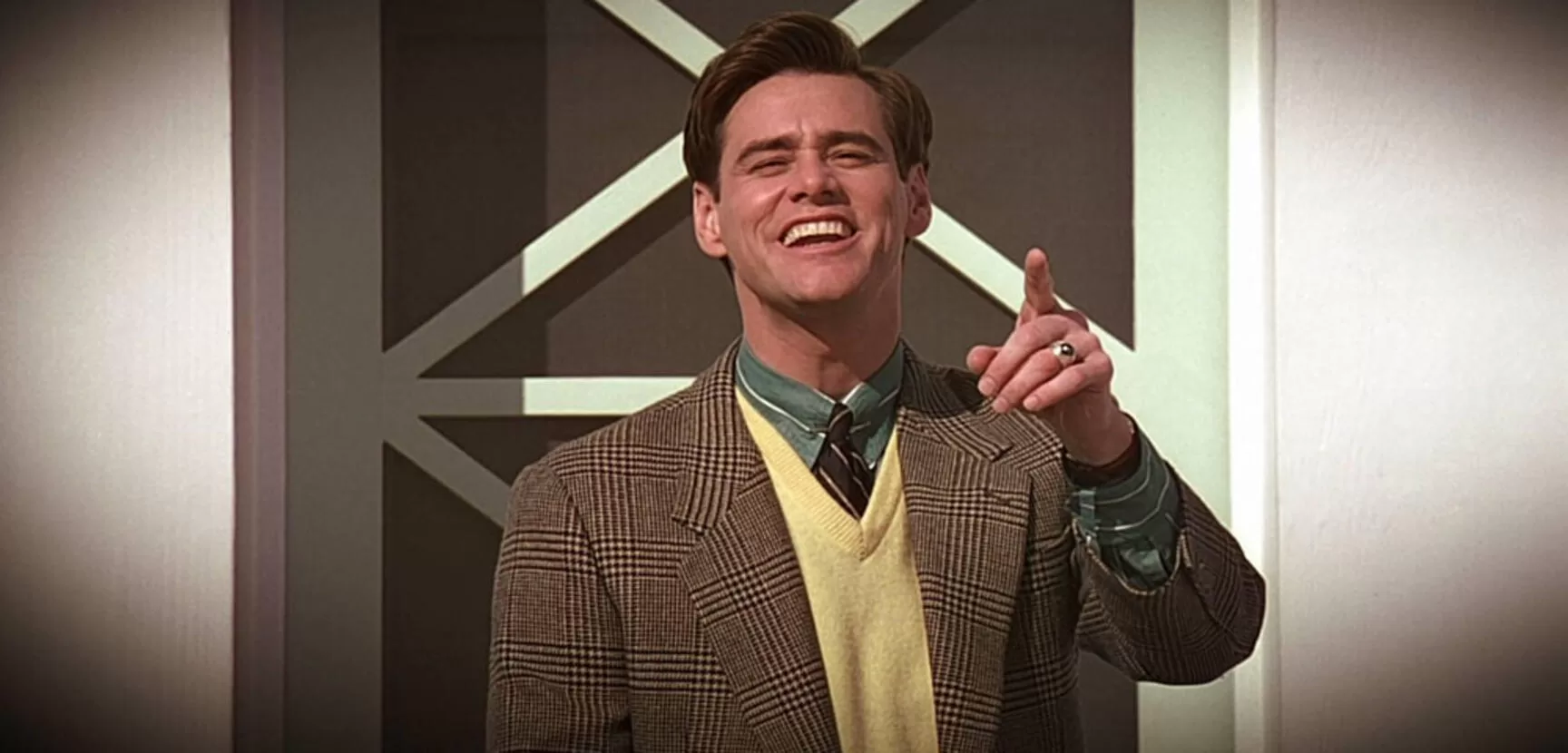









I need to hunt down more about this. I am completely intrigued.
It’s interesting to read this and learn about what media and topics are circulating since I don’t watch any of this. I’ve cut out 99% of media content for almost 13 years now because I strongly believe it creates a false transmudane. What’s most worrisome isn’t the themes (though they are) but normative social interaction is shifted increasingly liberal by norms in movies via mirror neurons among other processes. The more isolated people are, the more they replace social norms of a community with tv.
I strongly believe the brain and cognition in itself is a conduit for the spiritual into the physical world. I strongly doubt it is even possible for them to capture memories in any human way into a mechanical model, let alone actual consciousness. I don’t believe it is possible.
I process almost all of my ideas through my dreams or get them from dreams. I dreamed of Lycurgus before I even knew who he was and became obsessed with Sparta a decade ago because of it. The vast majority of my writing is inspired by or processed through dreams… and I’ve learned many weird things that were very useful and meaningful in waking life from dreams including even an alt account’s identity.
Such odd themes going on in the media. I’m sure they will try, but they will not be able to mechanically control or trap consciousness. Far more likely to end life itself on this planet long before that technology would be made if it is even possible.
Surprised not to see Richard Morgan’s “Altered Carbon” mentioned.
The book touches on these kind of topics… a great read. It was made into a series for any interested, where the first season was worth watching.